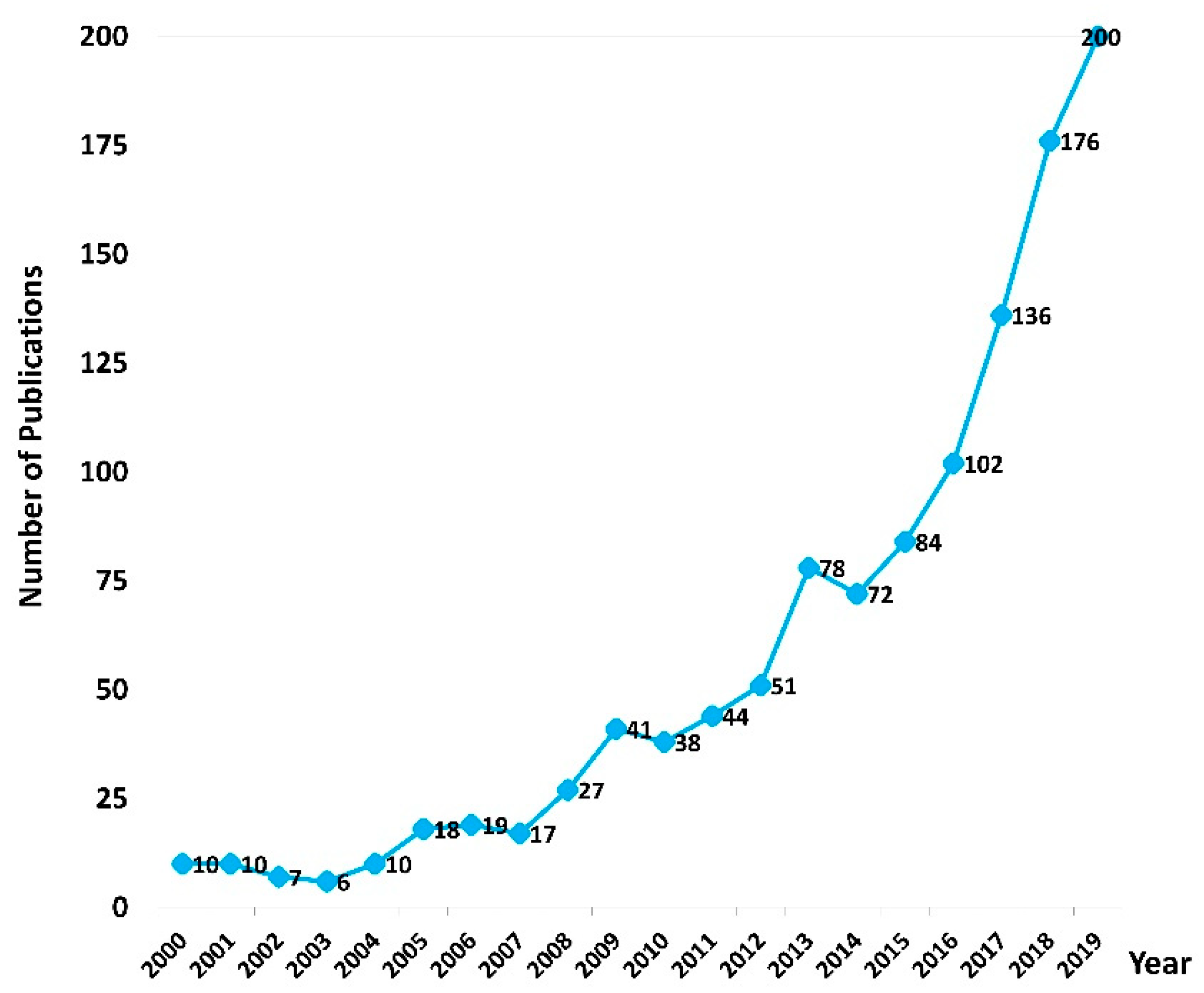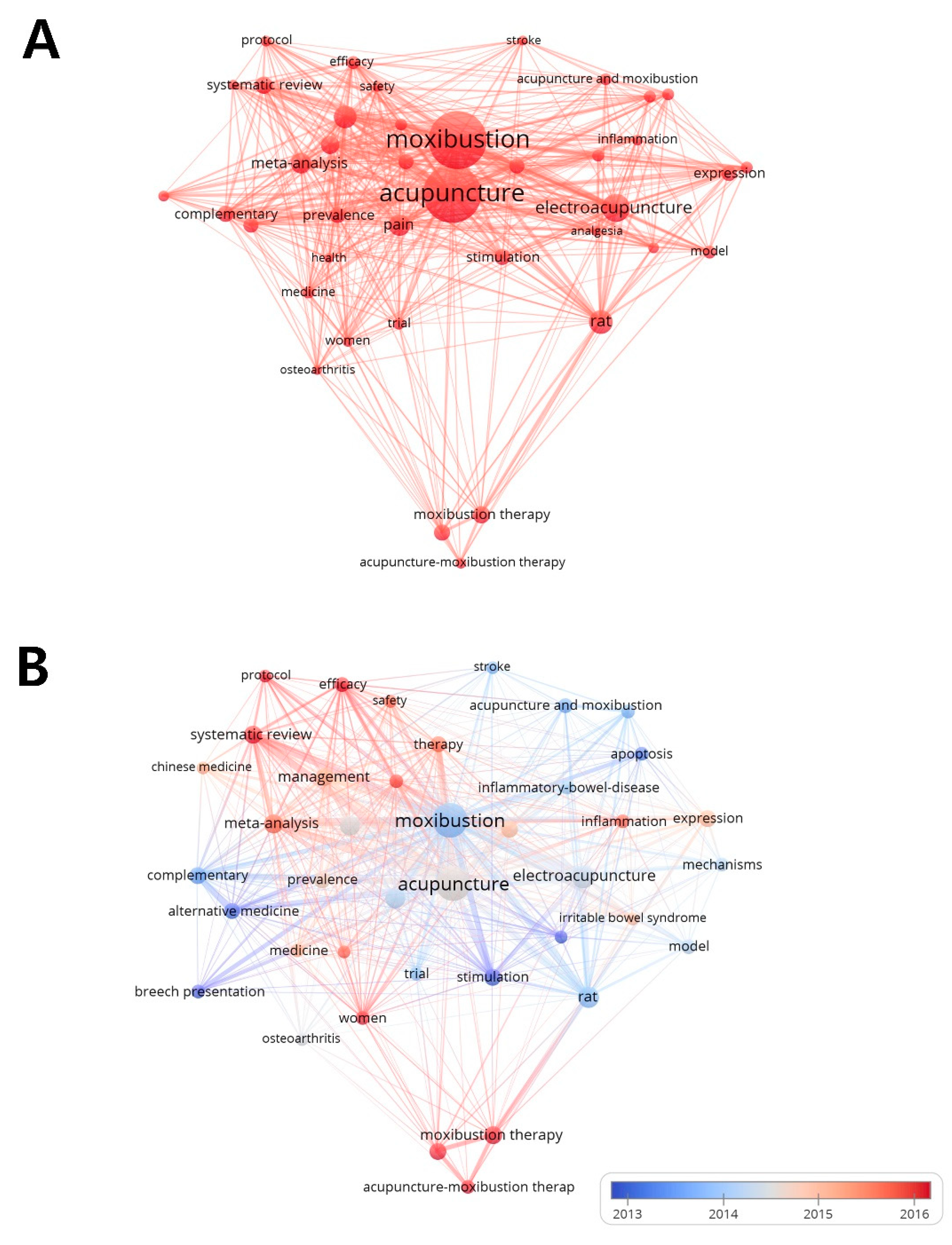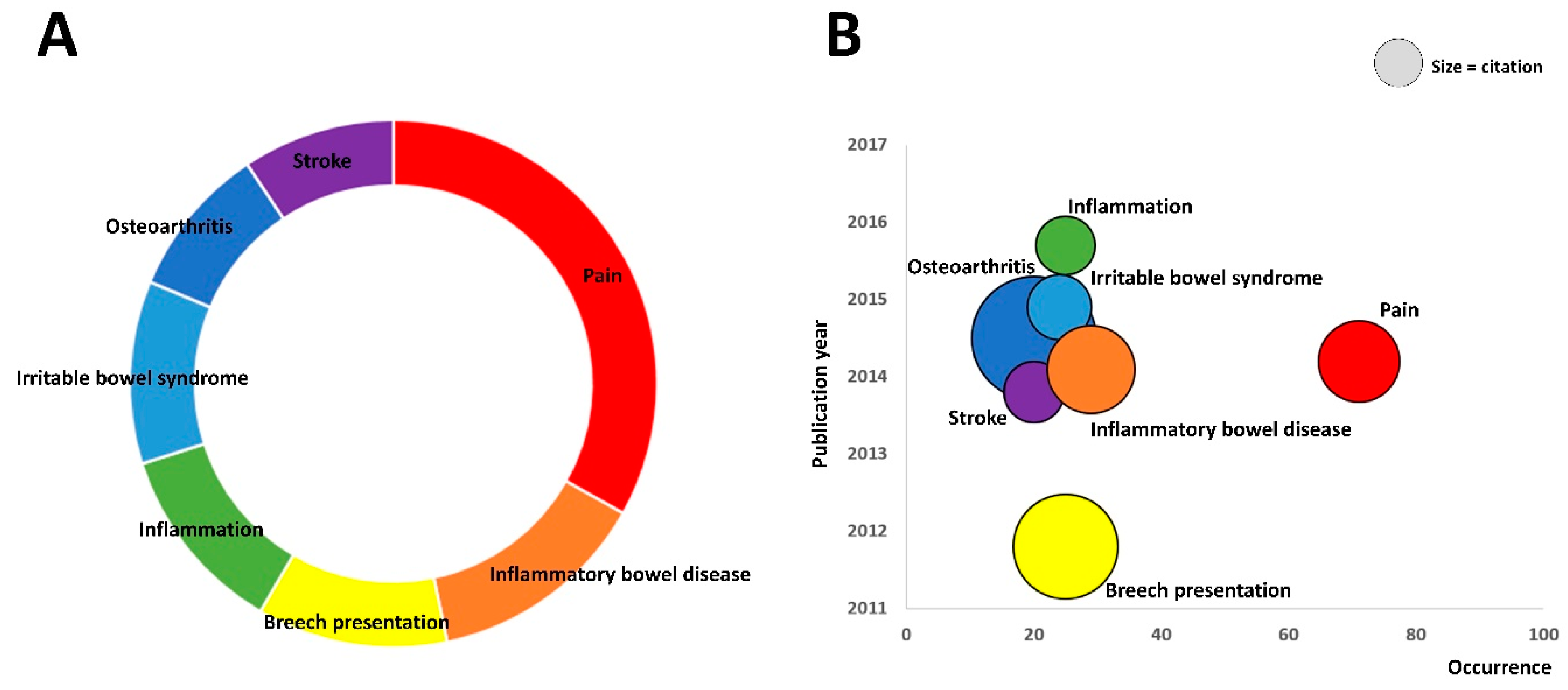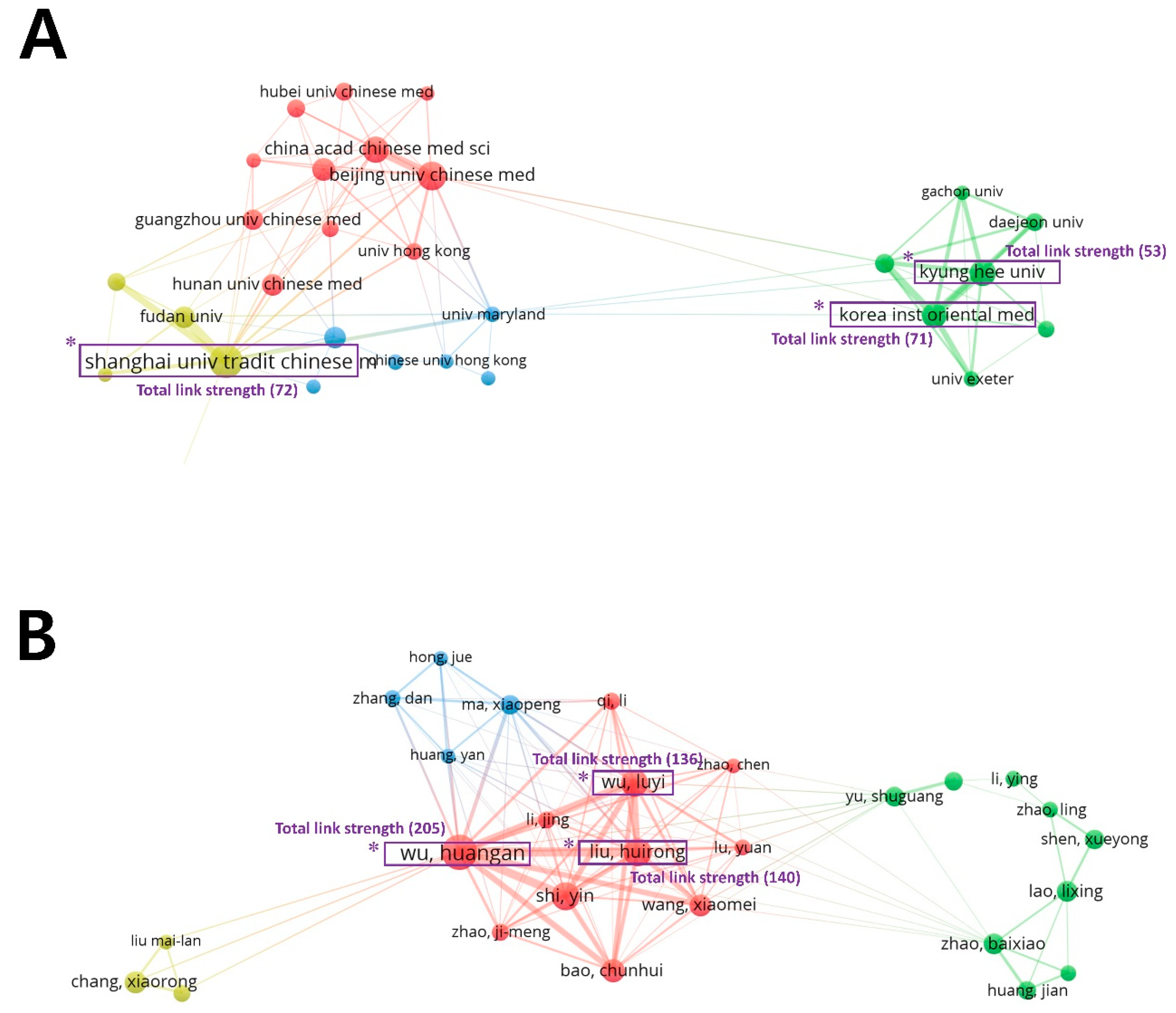Bibliometric Analysis of Moxibustion Research Trends Over the Past 20 Years
Abstract
1. Introduction
2. Methods
2.1. Data Sources and Search Strategy
2.2. Data Acquisition and Cleaning
2.3. Data Analysis
3. Results
3.1. Global Trends in Studies Investigating Moxibustion Over the Past 20 Years
3.2. Analysis of Research Areas and Journals
3.3. Analysis of Keywords
3.4. Analysis of Main Diseases Using Moxibustions
3.5. Analysis of Organizations and Authors
3.6. Analysis of Total Link Strength of Organizations and Authors
4. Discussion
Author Contributions
Funding
Conflicts of Interest
References
- Deng, H.; Shen, X. The mechanism of moxibustion: ancient theory and modern research. Evid. Based. Complement. Alternat. Med. 2013, 2013, 379291. [Google Scholar] [CrossRef] [PubMed]
- Han, C.H.; Shin, M.S.; Shin, S.H.; Kang, K.W.; Park, S.H.; Choi, S.M. Telephone survey for grasping clinical actual stage of moxibustion therapeutics in Korea. Kor. J. Acu. 2007, 24, 17–31. [Google Scholar]
- Joos, S.; Brinkhaus, B.; Maluche, C.; Maupai, N.; Kohnen, R.; Kraehmer, N.; Hahn, E.G.; Schuppan, D. Acupuncture and moxibustion in the treatment of active Crohn’s disease: a randomized controlled study. Digestion. 2004, 69, 131–139. [Google Scholar] [CrossRef] [PubMed]
- Yamashita, H.; Ichiman, Y.; Tanno, Y. Changes in peripheral lymphocyte subpopulations after direct moxibustion. Am. J. Chin. Med. 2001, 29, 227–235. [Google Scholar] [CrossRef]
- Kim, S.Y.; Chae, Y.; Lee, S.M.; Lee, H.; Park, H.J. The effectiveness of moxibustion: an overview during 10 years. Evid. Based Complement. Alternat. Med. 2011, 2011, 306515. [Google Scholar] [CrossRef]
- Shen, J.; Ai, B.; Shen, M. Effectiveness of Mild Moxibustion for Sub-Health Conditions in Pre- and Post-Menopausal Women: A Randomized Controlled Clinical Trial. Med. Sci. Monit. 2018, 24, 2907–2911. [Google Scholar] [CrossRef]
- Schlaeger, J.M.; Stoffel, C.L.; Bussell, J.L.; Cai, H.Y.; Takayama, M.; Yajima, H.; Takakura, N. Moxibustion for Cephalic Version of Breech Presentation. J. Midwifery Womens Health. 2018, 63, 309–322. [Google Scholar] [CrossRef]
- Lee, M.S.; Shin, B.C.; Kim, J.I.; Han, C.H.; Ernst, E. Moxibustion for stroke rehabilitation: systematic review. Stroke. 2010, 41, 817–820. [Google Scholar] [CrossRef]
- Park, J.W.; Lee, B.H.; Lee, H. Moxibustion in the management of irritable bowel syndrome: systematic review and meta-analysis. B.M.C. Complement. Altern. Med. 2013, 13, 247. [Google Scholar] [CrossRef]
- Chen, P.B.; Qi, S.S.; Cui, J.; Yang, X.F.; Chen, J.; Wang, X.G.; Yang, Z.H.; Feng, L.; Xuan, J. Herbal-cake-partitioned moxibustion of “Shenque” (CV8) has a relative specific effect in relieving abdominal pain and in regulating neuroendocrine-immune network in primary dysmenorrhea rats. Zhen Ci Yan Jiu. 2019, 44, 120–124. [Google Scholar] [CrossRef]
- Bao, C.H.; Wang, C.Y.; Li, G.N.; Yan, Y.L.; Wang, D.; Jin, X.M.; Wu, L.Y.; Liu, H.R.; Wang, X.M.; Shi, Z.; et al. Effect of mild moxibustion on intestinal microbiota and NLRP6 inflammasome signaling in rats with post-inflammatory irritable bowel syndrome. World J Gastroenterol. 2019, 25, 4696–4714. [Google Scholar] [CrossRef] [PubMed]
- Jain, S.; Basavaraj, P.; Singla, A.; Singh, K.; Kundu, H.; Vashishtha, V.; Pandita, V.; Malhi, R. Bibliometric analysis of journal of clinical and diagnostic research (dentistry section; 2007–2014). J. Clin. Diagn. Res. 2015, 9, 47–51. [Google Scholar] [CrossRef] [PubMed]
- van Eck, N.J.; Waltman, L. Software survey: VOSviewer, a computer program for bibliometric mapping. Scientometrics. 2010, 84, 523–538. [Google Scholar] [CrossRef] [PubMed]
- Zhao, J.; Yu, G.; Cai, M.; Lei, X.; Yang, Y.; Wang, Q.; Zhai, X. Bibliometric analysis of global scientific activity on umbilical cord mesenchymal stem cells: a swiftly expanding and shifting focus. Stem Cell Res. Ther. 2018, 9, 32. [Google Scholar] [CrossRef]
- Lee, I.S.; Lee, H.; Chen, Y.H.; Chae, Y. Bibliometric Analysis of Research Assessing the Use of Acupuncture for Pain Treatment Over the Past 20 Years. J. Pain Res. 2020, 13, 367–376. [Google Scholar] [CrossRef]
- Ma, Y.; Dong, M.; Zhou, K.; Mita, C.; Liu, J.; Wayne, P.M. Publication Trends in Acupuncture Research: A 20-Year Bibliometric Analysis Based on PubMed. PLoS One. 2016, 11, e0168123. [Google Scholar] [CrossRef]
- Jeon, S.H.; Lee, I.S.; Lee, H.; Chae, Y. A bibliometric analysis of acupuncture research trends in clinical trials. Kor. J. Acu. 2019, 36, 281–291. [Google Scholar] [CrossRef]
- Pinto, M.; Pulgarin, A.; Escalona, M.I. Viewing information literacy concepts: a comparison of two branches of knowledge. Scientometrics. 2004, 98, 2311–2329. [Google Scholar] [CrossRef]
- Peng, X.; Dai, J. A bibliometric analysis of neutrosophic set: two decades review from 1998 to 2017. Artificial Intelligence Review. 2020, 53, 199–255. [Google Scholar] [CrossRef]
- Khudzari, J.; Kurian, J.; Tartakovsky, B.; Raghavan, G. Bibliometric analysis of global research trends on microbial fuel cells using scopus database. Biochem. Eng. J. 2018, 136, 51–60. [Google Scholar] [CrossRef]
- Tang, B.; Zhang, J.; Yang, Z.; Lu, Y.; Xu, Q.; Chen, X.; Lin, J. Moxibustion for Diarrhea-Predominant Irritable Bowel Syndrome: A Systematic Review and Meta-Analysis of Randomized Controlled Trials. Evid. Based Complement. Alternat. Med. 2016, 2016, 5105108. [Google Scholar] [CrossRef]
- Choi, T.Y.; Choi, J.; Kim, K.H.; Lee, M.S. Moxibustion for the treatment of osteoarthritis: a systematic review and meta-analysis. Rheumatol. Int. 2012, 32, 2969–2978. [Google Scholar] [CrossRef]
- Li, A.; Wei, Z.J.; Liu, Y.; Li, B.; Guo, X.; Feng, S.Q. Moxibustion Treatment for Knee Osteoarthritis: A Systematic Review and Meta-Analysis. Medicine. 2016, 95, e3244. [Google Scholar] [CrossRef]
- Bue, L.; Lauszus, F.F. Moxibustion did not have an effect in a randomised clinical trial for version of breech position. Dan. Med. J. 2016, 63. [Google Scholar]
- Coyle, M.E.; Smith, C.A.; Peat, B. Cephalic version by moxibustion for breech presentation. Cochrane Database Syst. Rev. 2012, 5, CD003928. [Google Scholar] [CrossRef]
- Ewies, A.; Olah, K. Moxibustion in breech version-a descriptive review. Acupunct. Med. 2002, 20, 26–29. [Google Scholar] [CrossRef]
- Li, Y.; Qian, Z.Y.; Cheng, K.; Zhao, L.; Shen, X.Y.; Deng, H.P. Effect of Compound Laser Acupuncture-Moxibustion on Blood Glucose, Fasting Insulin and Blood Lipids Levels in Type 2 Diabetic Rats. Chin. J. Integr. Med. 2020, 26, 33–38. [Google Scholar] [CrossRef]
- Kwon, C.Y.; Lee, B.; Park, K.S. Oriental herbal medicine and moxibustion for polycystic ovary syndrome: A meta-analysis. Medicine (Baltimore). 2018, 97, e12942. [Google Scholar] [CrossRef]
- Bao, C.; Wu, L.; Wu, H.; Liu, H.; Zhao, J.; Zeng, X. Active Crohn’s disease treated with acupuncture and moxibustion:a randomized controlled trial. Zhongguo Zhen Jiu. 2016, 36, 683–688. [Google Scholar] [CrossRef]
- Qi, Q.; Liu, Y.N.; Jin, X.M.; Zhang, L.S.; Wang, C.; Bao, C.H.; Liu, H.R.; Wu, H.G.; Wang, X.M. Moxibustion treatment modulates the gut microbiota and immune function in a dextran sulphate sodium-induced colitis rat model. World J. Gastroenterol. 2018, 24, 3130–3144. [Google Scholar] [CrossRef]
- Wang, X.; Qi, Q.; Wang, Y.; Wu, H.; Jin, X.; Yao, H.; Jin, D.; Liu, Y.; Wang, C. Gut microbiota was modulated by moxibustion stimulation in rats with irritable bowel syndrome. Chin. Med. 2018, 13, 63. [Google Scholar] [CrossRef]
- Matsumoto, H.; Shimada, J.; Nagasaka, H.; Matsumoto, I.; Hashimoto, K.; Sakagami, H. Inhibition by Moxa smoke of NO production and iNOS expression in mouse macrophage-like cells Raw 264.7. In Vivo. 2005, 19, 471–474. [Google Scholar]
- Xu, H.; Zhao, B.; Cui, Y.; Lim, M.Y.; Liu, P.; Han, L.; Guo, H.; Lao, L. Effects of Moxa Smoke on Monoamine Neurotransmitters in SAMP8 Mice. Evid. Based. Complement. Alternat. Med. 2013, 2013, 178067. [Google Scholar] [CrossRef]
- Hitosugi, N.; Ohno, R.; Hatsukari, I.; Mizukami, S.; Nagasaka, H.; Matsumoto, I.; Komatsu, N.; Fujimaki, M.; Nakashima, H.; Satoh, K.; et al. Diverse biological activities of moxa extract and smoke. In Vivo. 2001, 15, 249–254. [Google Scholar]
- Hitosugi, N.; Ohno, R.; Hatsukari, I.; Nakamura, S.; Mizukami, S.; Nagasaka, H.; Matsumoto, I.; Satoh, K.; Negoro, T.; Hashimoto, K.; et al. Induction of cell death by pro-oxidant action of Moxa smoke. Anticancer Res. 2002, 22, 159–163. [Google Scholar]
- Sakagami, H.; Matsumoto, H.; Satoh, K.; Shioda, S.; Ali, C.S.; Hashimoto, K.; Kikuchi, H.; Nishikawa, H.; Terakubo, S.; Shoji, Y.; et al. Cytotoxicity and radical modulating activity of Moxa smoke. In Vivo. 2005, 19, 391–397. [Google Scholar]
- Lim, M.Y.; Huang, J.; Zhao, B. Standardisation of moxibustion: challenges and future development. Acupunct. Med. 2015, 33, 142–147. [Google Scholar] [CrossRef]




| Rank | Country/Regions | Articles (n), % of the Total Number of Articles (1146) |
|---|---|---|
| 1 | China | n = 719, 62.7% |
| 2 | South Korea | n = 147, 12.8% |
| 3 | USA | n = 123, 10.7% |
| 4 | Japan | n = 67, 5.8% |
| 5 | Germany | n = 43, 3.8% |
| 6 | England | n = 35, 3.1% |
| 7 | Taiwan | n = 32, 2.8% |
| 8 | Australia | n = 21, 1.8% |
| 9 | Brazil | n = 20, 1.7% |
| 10 | Canada | n = 11, 1.0% |
| Rank | Research Area | Articles (n), % of the Total Number of Articles (1146) | Rank | Journal Title | Articles (n), % of the Total Number of Articles (1146) |
|---|---|---|---|---|---|
| 1 | Integrative Complementary Medicine | n = 672, 58.6% | 1 | World Journal of Acupuncture-Moxibustion | n = 171, 14.9% |
| 2 | General Internal Medicine | n = 86, 7.5% | 2 | Evidence-based Complementary and Alternative Medicine | n = 123, 10.7% |
| 3 | Neurosciences Neurology | n = 71, 6.2% | 3 | Journal of Acupuncture and Tuina Science | n = 66, 5.8% |
| 4 | Research Experimental Medicine | n = 59, 5.1% | 4 | Journal of Traditional Chinese Medicine | n = 63, 5.5% |
| 5 | Cell Biology | n = 44, 3.8% | 5 | Neural Regeneration Research | n = 40, 3.5% |
| 6 | Gastroenterology Hepatology | n = 42, 3.7% | 6 | Medicine | n = 31, 2.7% |
| 7 | Engineering | n = 28, 2.4% | 7 | Journal of Alternative and Complementary Medicine | n = 30, 2.6% |
| 8 | Pharmacology Pharmacy | n = 27, 2.4% | 8 | Acupuncture in Medicine | n = 28, 2.4% |
| 9 | Geochemistry Geophysics | n = 26, 2.3% | 9 | European Journal of Integrative Medicine | n = 27, 2.4% |
| 10 | Oncology | n = 24, 2.1% | 10 | Chinese Journal of Integrative Medicine | n = 26, 2.3% |
| Keywords | Weight (Occurrences) | Score (Avg. Pub. Year) | Score (Avg. Citations) | |
|---|---|---|---|---|
| 1 | moxibustion | 346 | 2013.9 | 7.9 |
| 2 | acupuncture | 343 | 2014.5 | 8.5 |
| 3 | electroacupuncture | 110 | 2014.4 | 6.6 |
| 4 | rat | 82 | 2013.8 | 8.0 |
| 5 | randomized controlled trial | 80 | 2014.5 | 8.0 |
| 6 | pain | 71 | 2014.2 | 10.5 |
| 7 | meta-analysis | 65 | 2015.6 | 6.7 |
| 8 | management | 57 | 2015.1 | 9.9 |
| 9 | systematic review | 52 | 2015.9 | 8.7 |
| 10 | moxibustion therapy | 52 | 2017.7 | 0.7 |
| 11 | prevalence | 48 | 2014.7 | 8.9 |
| 12 | complementary | 47 | 2013.5 | 16.8 |
| 13 | stimulation | 47 | 2012.5 | 9.6 |
| 14 | acupuncture therapy | 46 | 2017.2 | 1.0 |
| 15 | traditional Chinese medicine | 44 | 2014.9 | 9.6 |
| 16 | expression | 44 | 2014.9 | 6.1 |
| 17 | alternative medicine | 41 | 2013.1 | 21.3 |
| 18 | therapy | 41 | 2015.6 | 6.3 |
| 19 | efficacy | 35 | 2016.0 | 5.5 |
| 20 | model | 31 | 2014.2 | 8.3 |
| 21 | acupuncture and moxibustion | 30 | 2013.7 | 7.0 |
| 22 | inflammatory bowel disease | 29 | 2014.1 | 12.2 |
| 23 | trial | 28 | 2013.9 | 10.6 |
| 24 | mechanisms | 27 | 2014.2 | 8.8 |
| 25 | quality-of-life | 27 | 2015.8 | 7.9 |
| 26 | medicine | 27 | 2015.1 | 7.8 |
| 27 | apoptosis | 27 | 2013.2 | 6.5 |
| 28 | neural regeneration | 27 | 2013.8 | 5.4 |
| 29 | acupuncture–moxibustion therapy | 26 | 2018.0 | 0.1 |
| 30 | breech presentation | 25 | 2011.8 | 17.2 |
| 31 | women | 25 | 2016.4 | 5.7 |
| 32 | inflammation | 25 | 2015.7 | 5.6 |
| 33 | irritable bowel syndrome | 24 | 2014.9 | 6.7 |
| 34 | protocol | 24 | 2017.3 | 1.8 |
| 35 | safety | 22 | 2015.6 | 17.9 |
| 36 | Chinese medicine | 22 | 2015.1 | 6.7 |
| 37 | osteoarthritis | 20 | 2014.5 | 23.9 |
| 38 | analgesia | 20 | 2011.6 | 17.5 |
| 39 | health | 20 | 2015.7 | 8.0 |
| 40 | stroke | 20 | 2013.8 | 6.0 |
| Rank | Organization | Articles (n), % of the Total Number of Articles (1146) | Rank | Author | Articles (n), % of the Total Number of Articles (1146) |
|---|---|---|---|---|---|
| 1 | Shanghai University of Traditional Chinese Medicine | n = 113, 9.9% | 1 | Wu, Huangan | n = 61, 5.3% |
| 2 | Beijing University of Chinese Medicine | n = 68, 5.9% | 2 | Liu, Huirong | n = 40, 3.5% |
| 3 | China Academy of Chinese Medical Sciences | n = 58, 5.1% | 3 | Wu, Luyi | n = 36, 3.1% |
| 4 | Kyung Hee University | n = 57, 5.0% | 4 | Shi, Yin | n = 35, 3.1% |
| 5 | Korea Institute of Oriental Medicine | n = 51, 4.5% | 5 | Lee, Myeong Soo | n = 33, 2.9% |
| 6 | Chengdu University of Traditional Chinese Medicine | n = 36, 3.1% | 6 | Chen, Rixin | n = 25, 2.2% |
| 7 | Nanjing University of Chinese Medicine | n = 34, 3.0% | 7 | Bao, Chunhui | n = 24, 2.1% |
| 8 | Hunan University of Chinese Medicine | n = 32, 2.8% | 8 | Chang, Xiaorong | n = 24, 2.1% |
| 9 | Fudan University | n = 31, 2.7% | 9 | Zhao, Baixiao | n = 24, 2.1% |
| 10 | Guangzhou University of Chinese Medicine | n = 27, 2.4% | 10 | Wang, Jing | n = 21, 1.8% |
| Rank | Organization | Total Link Strength | Rank | Author | Total Link Strength |
|---|---|---|---|---|---|
| 1 | Shanghai University of Traditional Chinese Medicine | 72 | 1 | Wu, Huangan | 205 |
| 2 | Korea Institute of Oriental Medicine | 71 | 2 | Liu, Huirong | 140 |
| 3 | Kyung Hee University | 53 | 3 | Wu, Luyi | 136 |
| 4 | Beijing University of Chinese Medicine | 49 | 4 | Shi, Yin | 112 |
| 5 | Pusan National University | 41 | 5 | Bao, Chunhui | 83 |
| 6 | China Academy of Chinese Medical Sciences | 39 | 6 | Wang, Xiaomei | 71 |
| 7 | Fudan University | 32 | 7 | Ma, Xiaopeng | 58 |
| 8 | Daejeon University | 27 | 8 | Lu, Yuan | 36 |
| 9 | Gachon University | 26 | 9 | Huang, Yan | 29 |
| 10 | University of Exeter | 23 | 10 | Zhao, Chen | 28 |
© 2020 by the authors. Licensee MDPI, Basel, Switzerland. This article is an open access article distributed under the terms and conditions of the Creative Commons Attribution (CC BY) license (http://creativecommons.org/licenses/by/4.0/).
Share and Cite
Park, H.; Lee, I.-S.; Lee, H.; Chae, Y. Bibliometric Analysis of Moxibustion Research Trends Over the Past 20 Years. J. Clin. Med. 2020, 9, 1254. https://doi.org/10.3390/jcm9051254
Park H, Lee I-S, Lee H, Chae Y. Bibliometric Analysis of Moxibustion Research Trends Over the Past 20 Years. Journal of Clinical Medicine. 2020; 9(5):1254. https://doi.org/10.3390/jcm9051254
Chicago/Turabian StylePark, Hyejin, In-Seon Lee, Hyangsook Lee, and Younbyoung Chae. 2020. "Bibliometric Analysis of Moxibustion Research Trends Over the Past 20 Years" Journal of Clinical Medicine 9, no. 5: 1254. https://doi.org/10.3390/jcm9051254
APA StylePark, H., Lee, I.-S., Lee, H., & Chae, Y. (2020). Bibliometric Analysis of Moxibustion Research Trends Over the Past 20 Years. Journal of Clinical Medicine, 9(5), 1254. https://doi.org/10.3390/jcm9051254





